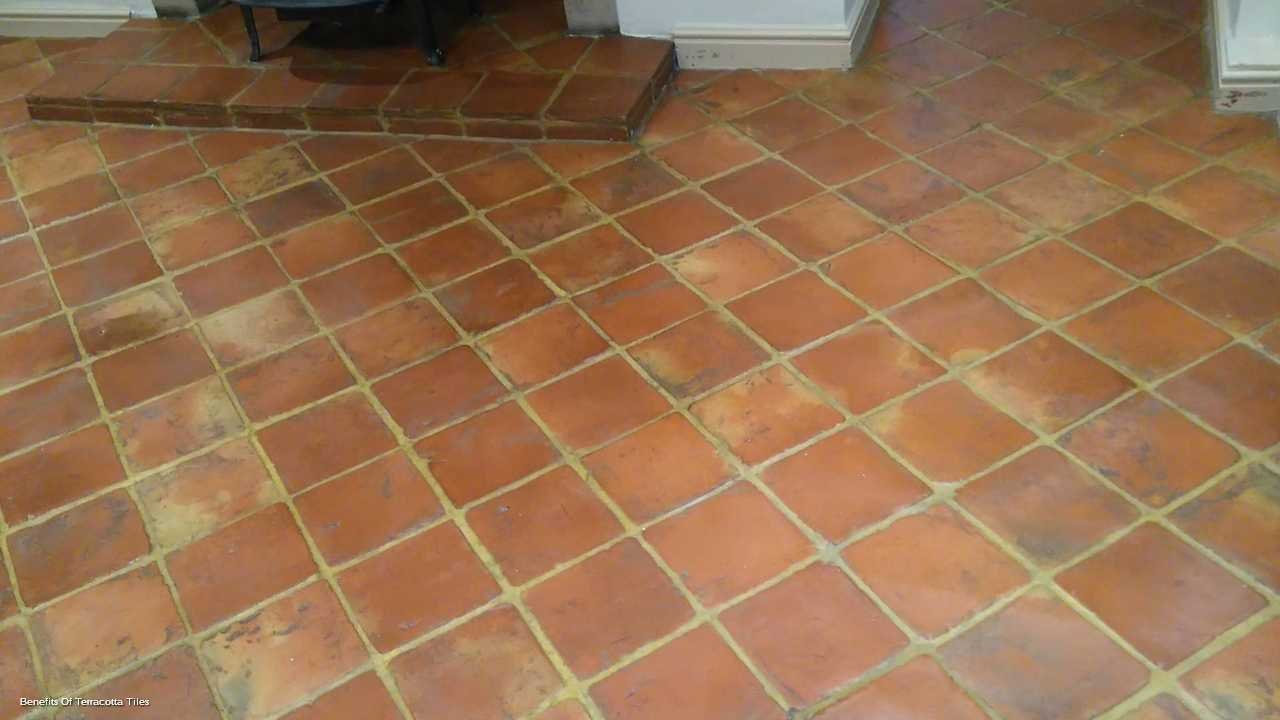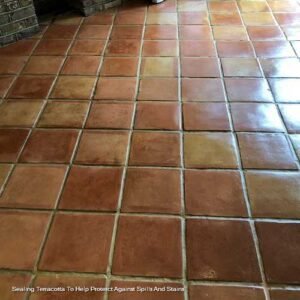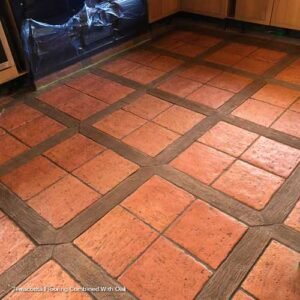


27 July 2024 by
sitemanager
The benefits of Terracotta Tiles are apparent when it comes to choosing the flooring for your home or commercial space. While there are numerous options available in the market. From hardwood to laminate, ceramic to vinyl, the choices can be overwhelming. However, if you are looking for a flooring option that exudes warmth, character, and timeless elegance, terracotta tiles should be at the top of your list. Terracotta tiles have been used for centuries and continue to be a popular choice in homes and commercial spaces due to their many advantages. In this blog post, we will explore why terracotta tiles are the perfect choice for adding warmth and timeless elegance to your home.
Terracotta, which translates to “baked earth” in Italian, is made from natural clay. This clay is shaped, fired at high temperatures, and then glazed to achieve its characteristic colour and finish. Terracotta tiles date back to ancient civilizations, including the Greeks, Romans, and Egyptians, who understood the benefits of terracotta tiles, especially their durability and aesthetics. Today, the tradition of using terracotta tiles continues, as they offer a unique charm and a link to the past.
 The use of terracotta dates back to the 3rd millennium BC. In Mesopotamia, the region now known as Iraq, artisans first discovered the durability and versatility of clay when subjected to high heat. The ancient Greeks and Romans further perfected the craft, using terracotta tiles not only for functional purposes but also as an art form. In Egypt, terracotta was a staple in building structures and crafting pottery, symbols of a sophisticated culture that revered this material.
The use of terracotta dates back to the 3rd millennium BC. In Mesopotamia, the region now known as Iraq, artisans first discovered the durability and versatility of clay when subjected to high heat. The ancient Greeks and Romans further perfected the craft, using terracotta tiles not only for functional purposes but also as an art form. In Egypt, terracotta was a staple in building structures and crafting pottery, symbols of a sophisticated culture that revered this material.
Over centuries, the methods of producing terracotta tiles have evolved. The initial rudimentary techniques involved simple hand-moulding and sun-drying. As civilizations progressed, the introduction of kilns allowed for higher temperatures and better consistency in tile quality. The Greeks introduced the use of moulds for uniform shapes, while the Romans refined these techniques, creating more intricate designs and patterns. This evolution showcases the ingenuity and adaptability of ancient cultures in utilizing natural resources.
Today, terracotta tiles are produced using both traditional and modern methods. Advanced kilns, glazing techniques, and precise shaping tools ensure a product that retains the timeless beauty of its ancient counterparts while meeting contemporary standards of quality and durability. This blend of old and new methods makes terracotta tiles a unique choice, bridging history with modern design sensibilities.

One of the most striking benefits of terracotta tiles is their warm, earthy tones. Ranging from shades of red to orange and brown, these tiles create a cosy and inviting atmosphere within any space. The natural hues of terracotta also complement various interior design styles, from rustic and Mediterranean to contemporary and minimalist. The warm undertones of terracotta tiles bring a sense of intimacy and comfort into your home, making it the perfect choice for kitchens, living rooms, and bedrooms.
The natural, earthy tones of terracotta tiles evoke a sense of warmth and cosiness. These hues are reminiscent of the earth, grounding the space and adding a natural touch to interiors. The colour palette of terracotta, which includes warm reds, oranges, and browns, blends seamlessly with various design styles, from rustic farmhouses to modern lofts. This versatility makes terracotta tiles an excellent choice for creating inviting and aesthetically pleasing environments.
Terracotta tiles’ ability to complement different interior design styles is one of their most significant advantages. In rustic and Mediterranean-inspired homes, terracotta enhances the traditional charm and character. In contemporary spaces, the tiles provide a striking contrast to sleek, modern furnishings, adding depth and warmth. Minimalist interiors benefit from the subtle textures and natural tones of terracotta, which introduce visual interest without overwhelming the simplicity of the design.
Terracotta tiles are incredibly versatile and can be used in various areas of the home. In kitchens, they add warmth and comfort, creating an inviting space for cooking and dining. Living rooms benefit from the cozy ambiance that terracotta tiles bring, making them perfect for relaxation and social gatherings. In bedrooms, the warm tones promote a serene and tranquil environment, ideal for rest and rejuvenation. This adaptability ensures that terracotta tiles can enhance any room in the house.
Terracotta tiles are renowned for their exceptional durability and longevity. When properly cared for, terracotta tiles can last for decades, if not centuries. Their resistance to wear and tear, stains, and water damage makes them an ideal choice for high-traffic areas and spaces prone to spills, such as kitchens, hallways, and dining areas. With minimal maintenance and regular sealing, terracotta tiles will retain their beauty and functionality for years to come.
The inherent strength of terracotta tiles comes from their composition and the firing process. Made from natural clay, these tiles are fired at high temperatures, which hardens the clay and enhances its durability. This process creates a material that is not only robust but also resistant to various forms of damage, including chipping and cracking. The durability of terracotta makes it an excellent choice for both residential and commercial spaces.
Terracotta tiles are particularly well-suited for high-traffic areas. Their ability to withstand heavy foot traffic without showing significant signs of wear and tear is one of their most appealing features. Whether in busy kitchens, bustling hallways, or frequently used living areas, terracotta tiles maintain their integrity and appearance over time. This resilience ensures that they remain a practical and attractive flooring option for years to come.
 One of the common concerns with flooring materials is their susceptibility to stains and water damage. Terracotta tiles, however, are naturally resistant to these issues. When properly sealed, terracotta tiles can repel stains and prevent water from penetrating the surface. This makes them ideal for areas prone to spills, such as kitchens and dining rooms. Regular sealing enhances this protective quality, ensuring that the tiles remain beautiful and functional.
One of the common concerns with flooring materials is their susceptibility to stains and water damage. Terracotta tiles, however, are naturally resistant to these issues. When properly sealed, terracotta tiles can repel stains and prevent water from penetrating the surface. This makes them ideal for areas prone to spills, such as kitchens and dining rooms. Regular sealing enhances this protective quality, ensuring that the tiles remain beautiful and functional.
One of the major benefits of Terracotta tiles is their ease of maintenance. Regular sweeping and damp mopping are usually sufficient to keep them clean. Avoiding harsh chemicals and abrasive cleaning tools will help preserve the tiles’ surface. Periodic sealing, typically every few years, adds an extra layer of protection against stains and water damage. With these minimal maintenance requirements, terracotta tiles offer a hassle-free flooring solution that retains its beauty and durability over time.
Terracotta tiles offer a plethora of design possibilities. Whether you prefer a traditional, rustic look or a more contemporary aesthetic, there is a terracotta tile style to suit your taste. From handmade tiles with an undulated surface to machine-made tiles with a smoother finish, you can choose the terracotta tile that best complements your overall interior design scheme. Additionally, terracotta tiles can be laid in various patterns, such as herringbone, basket-weave, or simple straight lines, allowing you to create a unique and visually appealing floor.
One of the significant advantages of terracotta tiles is the variety of styles and finishes available. Handmade tiles often feature a more rustic, undulated surface, adding character and charm to the space. Machine-made tiles, on the other hand, offer a smoother, more uniform finish, ideal for contemporary designs. This diversity in styles allows homeowners and designers to choose the perfect terracotta tile to match their aesthetic preferences and design goals.
The layout pattern of terracotta tiles can significantly impact the overall look and feel of a space. Traditional patterns, such as herringbone and basket-weave, add a classic touch, while straight-line layouts create a more modern appearance. Combining different patterns or incorporating decorative borders can further enhance the visual interest of the floor. These creative possibilities enable homeowners to personalize their spaces and create unique, eye-catching designs.
Terracotta tiles come in a range of natural colors, from deep reds and oranges to softer browns and creams. These color variations add depth and richness to the floor, creating a warm and inviting atmosphere. Customization options, such as mixing different colors or using tiles with decorative motifs, allow for even more personalized designs. This flexibility ensures that each terracotta tile installation is unique, reflecting the homeowner’s style and personality.
 Terracotta tiles can be seamlessly integrated with other materials to create a cohesive and harmonious design. Combining terracotta with natural stone, wood, or concrete can enhance the overall aesthetic and add textural contrast. For instance, pairing terracotta with wooden beams in a rustic kitchen or incorporating stone accents in a Mediterranean-inspired bathroom can create stunning visual effects. This versatility makes terracotta tiles an excellent choice for various design applications.
Terracotta tiles can be seamlessly integrated with other materials to create a cohesive and harmonious design. Combining terracotta with natural stone, wood, or concrete can enhance the overall aesthetic and add textural contrast. For instance, pairing terracotta with wooden beams in a rustic kitchen or incorporating stone accents in a Mediterranean-inspired bathroom can create stunning visual effects. This versatility makes terracotta tiles an excellent choice for various design applications.
If sustainability is an important factor for you, terracotta tiles are an excellent choice. Made from natural clay and fired at high temperatures, terracotta tiles have a low carbon footprint compared to other flooring materials. Additionally, these tiles are recyclable and can be repurposed at the end of their life cycle. By opting for terracotta tiles, you are making an environmentally conscious decision that aligns with the principles of sustainable living.
Terracotta tiles are made from natural clay, a renewable resource that is abundant and readily available. The production process involves extracting clay from the earth, shaping it into tiles, and firing it in kilns. This process has minimal environmental impact compared to the extraction and manufacturing of synthetic materials. Choosing terracotta tiles supports sustainable practices and reduces reliance on non-renewable resources.
The production of terracotta tiles has a relatively low carbon footprint. The energy required to fire the clay is significantly less than that needed for producing other flooring materials, such as ceramic or porcelain tiles. Additionally, many manufacturers use energy-efficient kilns and sustainable practices to further reduce their environmental impact. By selecting terracotta tiles, homeowners can contribute to lowering greenhouse gas emissions and promoting eco-friendly building practices.
At the end of their life cycle, terracotta tiles can be recycled or repurposed. The tiles can be crushed and used as aggregate in construction projects or repurposed for landscaping and garden pathways. This recyclability reduces waste and promotes a circular economy, where materials are continuously reused and repurposed. Choosing terracotta tiles aligns with sustainable living principles and supports efforts to minimize environmental impact.
Terracotta tiles are free from harmful chemicals and toxins commonly found in synthetic flooring materials. The natural composition of terracotta ensures that it does not emit volatile organic compounds (VOCs) or other harmful substances into the air. This makes terracotta tiles a healthy choice for indoor environments, contributing to better air quality and overall well-being. Homeowners can enjoy the aesthetic and functional benefits of terracotta tiles without compromising on health and safety.
While terracotta tiles are known for their durability, proper maintenance is still necessary to ensure their longevity. Regular sweeping and damp mopping will help keep the tiles clean and free from dirt and debris. It is important to avoid using harsh cleaning agents or abrasive materials that can damage the surface of the tiles. Applying a sealant every few years will protect the terracotta tiles from stains and water damage, further enhancing their durability.
Maintaining terracotta tiles involves regular cleaning to remove dust and dirt. Sweeping the floor daily with a soft broom or using a vacuum cleaner with a brush attachment will prevent dirt from accumulating and scratching the surface. Damp mopping with a mild, pH-neutral cleaner helps maintain the tiles’ natural shine and prevents the buildup of grime. Avoid using harsh chemicals, as they can erode the sealant and damage the tiles.
To protect terracotta tiles from stains and water damage, it is essential to apply a sealant periodically. The sealant creates a protective barrier that prevents liquids from penetrating the tiles and causing stains. In high-traffic areas or spaces prone to spills, consider using rugs or mats to provide an extra layer of protection. Promptly wiping up spills and avoiding abrasive cleaning tools will also help preserve the tiles’ surface and appearance.
Despite their durability, terracotta tiles can occasionally develop issues such as efflorescence, where white mineral deposits form on the surface. This is typically caused by moisture migrating through the tiles and bringing salts to the surface. To address this issue, clean the affected area with a vinegar and water solution, followed by resealing the tiles. Cracks and chips can be repaired using a color-matched filler, ensuring the tiles remain in excellent condition.
In addition to regular cleaning and sealing, long-term care for terracotta tiles involves periodic deep cleaning. This can be done using a specialized terracotta cleaner or a mixture of water and mild soap. Scrub the tiles gently with a soft brush, rinse thoroughly, and allow them to dry completely before applying a fresh coat of sealant. This routine will help maintain the tiles’ beauty and functionality for decades.
Terracotta tiles possess a timeless elegance that surpasses trends and fads. Regardless of the current design trends, terracotta tiles will always be a classic and sophisticated choice. Their warm hues and natural texture create a visual interest that adds depth and character to any space. Whether you have a traditional or modern interior, terracotta tiles will seamlessly integrate and elevate the overall aesthetic of your home.
The timeless appeal of terracotta tiles lies in their ability to blend seamlessly with various interior styles. In traditional settings, terracotta adds warmth and authenticity, complementing antique furniture and classic decor. In modern interiors, the natural texture and earthy tones of terracotta provide a striking contrast to sleek lines and minimalist designs. This versatility ensures that terracotta tiles remain a relevant and stylish choice regardless of changing design trends.
Terracotta tiles’ unique colour variations and textures create a dynamic visual impact that enhances the overall aesthetic of a space. Each tile is distinct, contributing to a rich and layered look that adds depth and character. This natural variation is particularly effective in large areas, where the interplay of colours and textures creates a captivating and inviting atmosphere. The inherent beauty of terracotta tiles makes them a focal point in any room.
Designers often integrate terracotta tiles into contemporary designs, even though they are commonly associated with traditional or rustic interiors. Combining terracotta with modern materials, such as wood, steel, and concrete, creates a unique and balanced aesthetic. For instance, a terracotta floor paired with minimalist furniture and industrial lighting results in a sophisticated yet welcoming space. This fusion of old and new highlights the adaptability and enduring appeal of terracotta tiles.
Choosing terracotta tiles connects homeowners with a rich architectural heritage. The use of terracotta dates back thousands of years, linking modern interiors with ancient traditions. This sense of continuity adds historical significance and depth to a space, making it more than just a living area but a part of a broader cultural narrative. Terracotta tiles offer a tangible connection to the past while providing the practicality and beauty needed for contemporary living.
If you need help cleaning and sealing your Terracotta floors, we are based nearby in New Malden. Call us at 01372-664-337 or let us know, and we will be happy to help.
Yes, terracotta tiles are an excellent choice for kitchen floors. Their durability, resistance to spills, and warm aesthetic make them a popular option for homeowners.
Yes, terracotta tiles are suitable for outdoor use. To withstand the elements, choose tiles specifically designed for outdoor applications and ensure you properly seal them.
With regular sweeping and damp mopping, terracotta tiles are relatively easy to maintain. Applying a sealant every few years will further protect the tiles from stains and water damage.
Terracotta tiles may experience slight fading over time, especially if exposed to direct sunlight. However, this natural patina only adds to the charm and character of the tiles.
Terracotta tiles are compatible with underfloor heating systems. However, it is essential to ensure proper installation and follow the manufacturer’s guidelines to prevent any damage to the tiles.